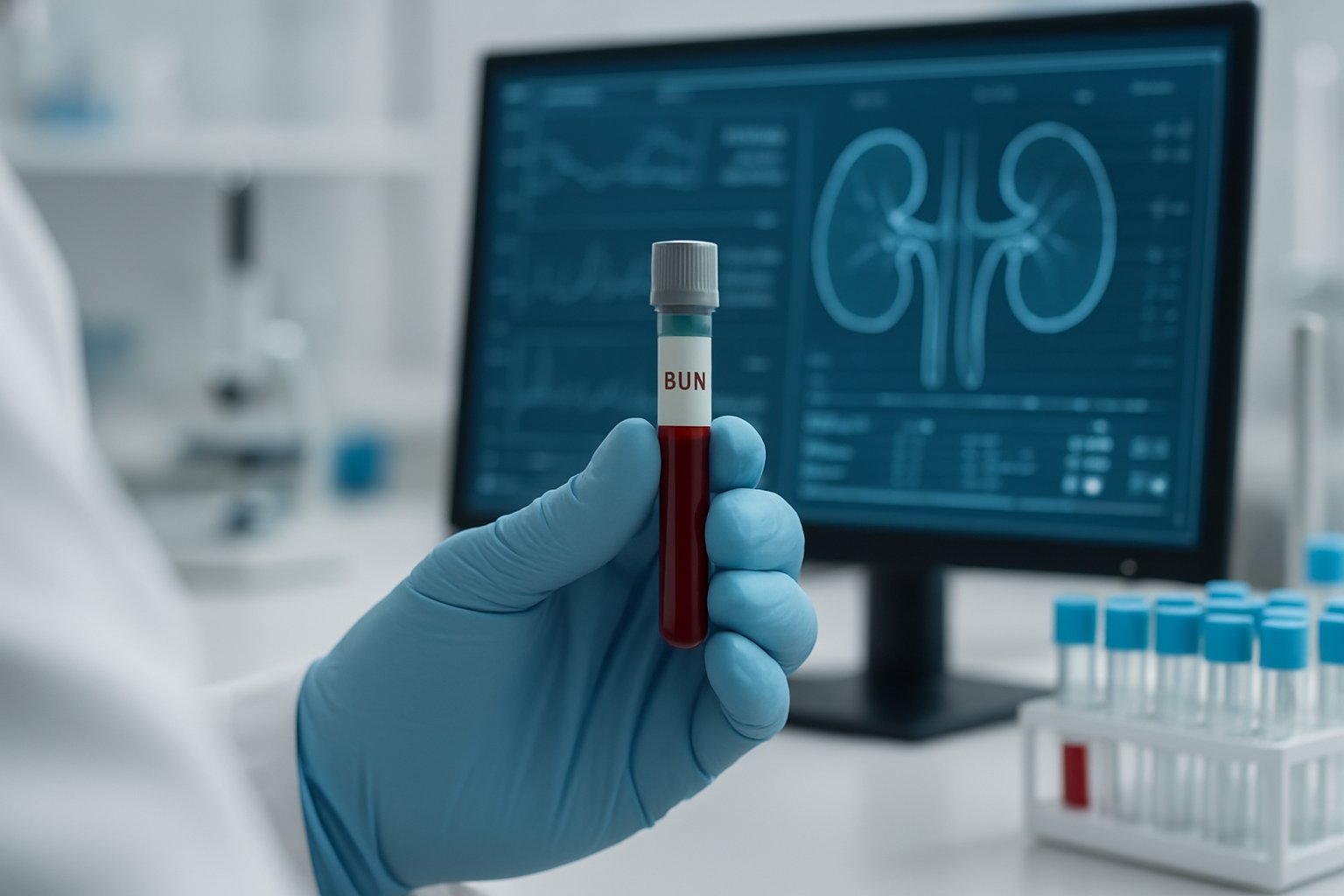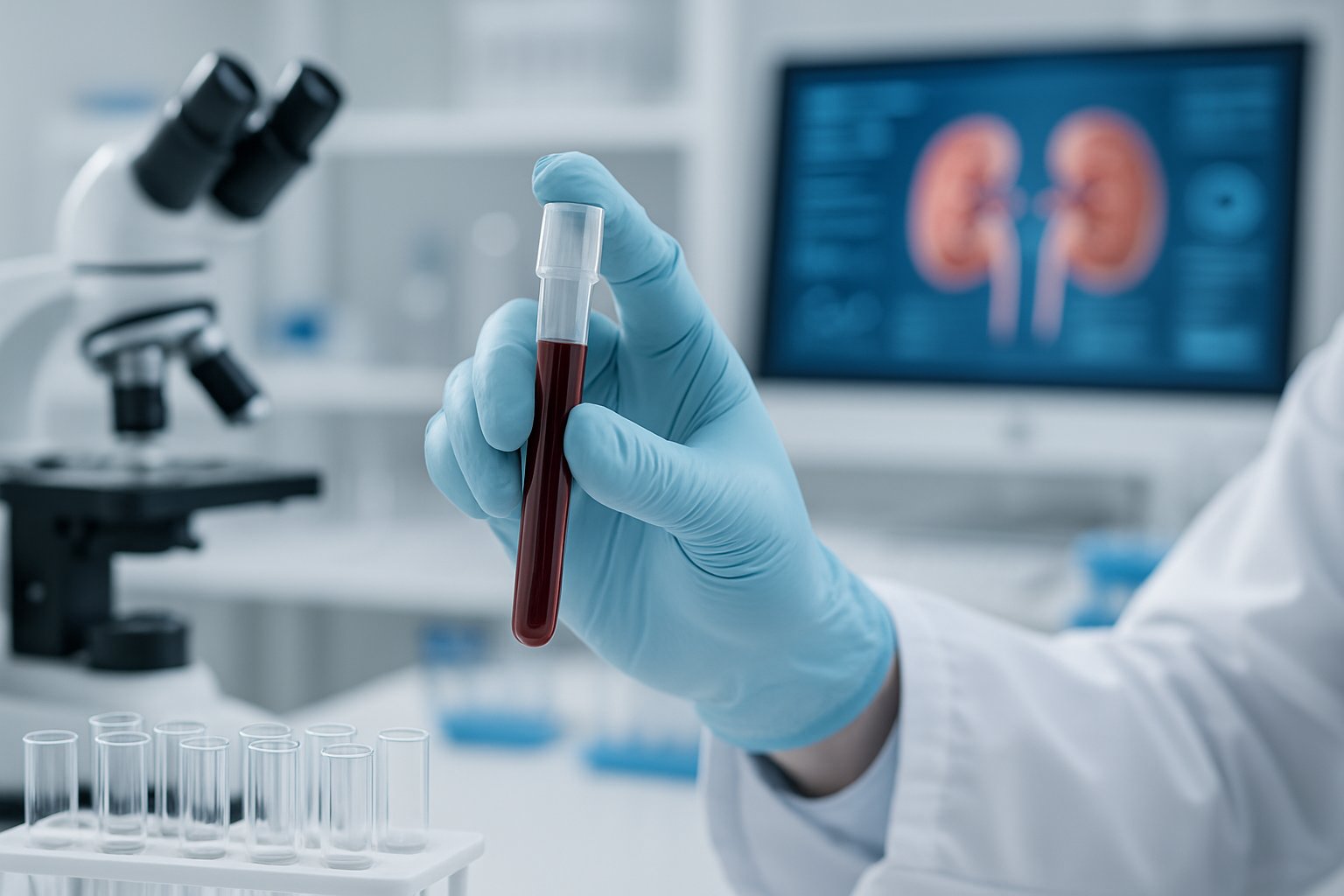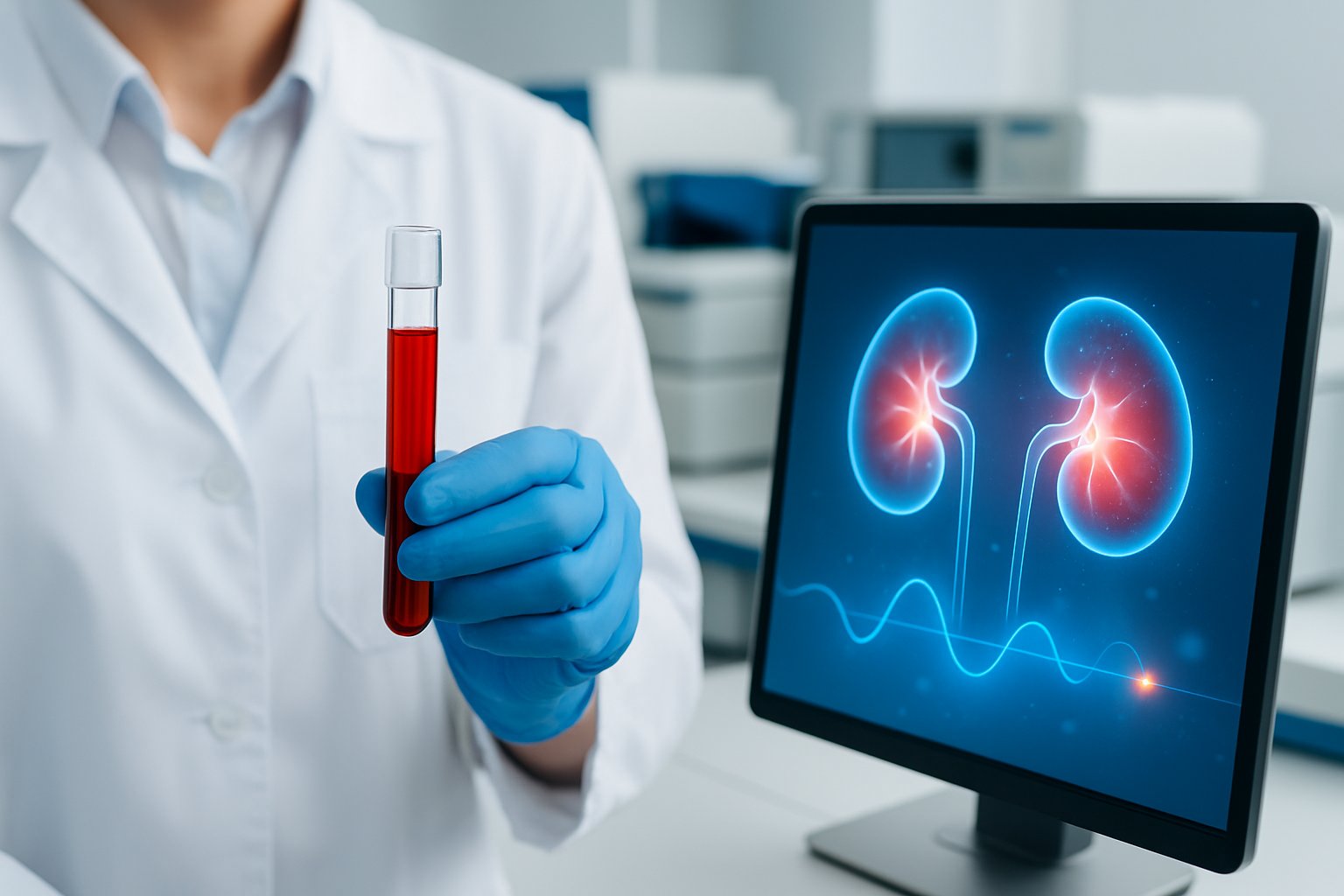When blood test results show high numbers, it can be scary. One test that often causes worry is the BUN test, which checks how well the kidneys work. Elevated BUN levels occur when blood urea nitrogen rises above the normal range of 7-21 mg/dL, often signaling kidney problems, dehydration, or other health issues.

Many people get confused about what BUN means and why doctors order this test. BUN measures urea nitrogen, a waste product that healthy kidneys should filter out. When BUN levels climb too high, it means the body cannot remove waste properly.
Understanding elevated BUN helps people make better health choices. High levels can come from kidney damage, not drinking enough water, eating too much protein, or taking certain medications. Learning about the causes and treatments gives patients the power to work with their doctors to fix the problem.
Key Takeaways
- BUN levels above 21 mg/dL indicate the kidneys may not be filtering waste products properly from the blood
- Common causes include dehydration, kidney disease, high protein intake, and certain medications that affect kidney function
- Treatment focuses on addressing the underlying cause, such as increasing fluid intake for dehydration or managing kidney disease
What Is BUN and Why Is It Important?

Blood urea nitrogen serves as a key indicator of kidney function and overall health. The kidneys and liver work together to produce and eliminate this waste product, with normal ranges varying based on individual factors.
Definition of Blood Urea Nitrogen (BUN)
Blood urea nitrogen is a waste product that forms when the body breaks down proteins. The BUN blood test measures the amount of urea nitrogen in your blood, providing doctors with important information about kidney function.
When proteins break down in the body, they create ammonia. The liver converts this toxic ammonia into urea, a safer compound. This urea contains nitrogen, which is why the test measures urea nitrogen levels.
Key components of BUN:
- Nitrogen from broken-down proteins
- Waste product normally filtered by kidneys
- Measured in milligrams per deciliter (mg/dL)
The blood urea nitrogen test reveals important information about how well your kidneys are working. Higher than normal urea nitrogen levels can signal problems with kidney function or other health issues.
Role of Kidneys and Liver in BUN Production
The liver and kidneys work as a team to manage urea nitrogen levels in the blood. This process happens continuously as the body processes proteins from food and cellular breakdown.
The liver produces ammonia when it breaks down proteins. Since ammonia is toxic to the body, the liver quickly converts it to urea. This conversion protects vital organs from damage.
Liver functions in BUN production:
- Converts toxic ammonia to safer urea
- Processes dietary proteins
- Handles protein breakdown from dead cells
Healthy kidneys filter urea from the blood and remove it through urine. The kidneys filter urea out of the blood and excrete it through urine, keeping blood levels within normal ranges.
When kidneys function poorly, urea nitrogen builds up in the blood. This causes BUN values to rise above normal levels. High levels may indicate kidney damage or reduced kidney function.
Normal BUN Ranges by Age and Gender
Normal BUN ranges help doctors determine if kidney function is healthy. These ranges can vary slightly between different laboratories and testing methods.
Standard BUN ranges:
- Adults: 7-20 mg/dL
- Children: 5-18 mg/dL
- Elderly adults: May be slightly higher due to natural kidney changes
BUN levels tend to be mildly increased as renal function naturally declines with age. This normal aging process affects how efficiently kidneys filter waste products.
Gender differences in BUN levels are typically minimal in healthy individuals. Men may have slightly higher values due to greater muscle mass and protein turnover.
Factors affecting normal ranges:
- Age-related kidney changes
- Muscle mass and protein intake
- Hydration status
- Overall health conditions
Doctors consider these factors when interpreting BUN test results. They often compare current values to previous tests to identify trends or changes in kidney function.
Understanding Elevated BUN Levels

Elevated BUN levels occur when blood urea nitrogen measurements exceed the normal range of 6-20 mg/dL in adults. High BUN levels can indicate kidney dysfunction, dehydration, or other medical conditions that affect protein metabolism or waste elimination.
What Constitutes Elevated BUN
Normal BUN levels range from 6 to 20 mg/dL in healthy adults. Children typically have lower levels, with a normal range of 5 to 18 mg/dL.
BUN levels exceeding 50 mg/dL are concerning and suggest serious kidney dysfunction. Levels above 100 mg/dL are considered critical medical emergencies.
BUN Level Classifications:
- Normal: 6-20 mg/dL
- Mildly elevated: 21-30 mg/dL
- Moderately elevated: 31-50 mg/dL
- Severely elevated: Above 50 mg/dL
- Critical: Above 100 mg/dL
Age affects normal ranges. Urea nitrogen levels tend to increase with age, while infants have lower baseline levels than adults.
Laboratory variations may cause slight differences in reference ranges. Healthcare providers always interpret results within the specific lab’s established parameters.
Potential Health Implications of High BUN
Elevated BUN typically indicates the kidneys cannot filter waste products effectively. High levels may indicate kidney damage from various underlying conditions.
Primary kidney-related causes include:
- Chronic kidney disease
- Acute kidney injury
- Kidney infections
- Kidney stones blocking urine flow
Non-kidney causes of elevated BUN:
- Dehydration reducing kidney blood flow
- Heart failure affecting kidney function
- High protein diet increasing waste production
- Gastrointestinal bleeding
- Certain medications
High blood pressure can both cause and result from elevated BUN. Hypertension damages kidney blood vessels over time, reducing their filtering ability.
Symptoms Linked to Elevated BUN
Mildly elevated BUN often produces no noticeable symptoms. Many people discover elevated levels during routine blood tests before symptoms appear.
Common symptoms of significantly elevated BUN include:
- Frequent urination, especially at night
- Changes in urine volume or appearance
- Blood or foam in urine
- Muscle cramps and fatigue
- Poor appetite and nausea
- Swelling in hands, feet, and face
Severely elevated BUN can cause uremia, a dangerous condition where waste products affect multiple organs. Signs and symptoms of uremia include nausea, vomiting, confusion, and seizures.
Critical BUN levels may lead to life-threatening complications. These include fluid buildup in the lungs, heart inflammation, and potentially coma without immediate treatment.
The severity of symptoms typically mirrors how elevated the BUN levels are and the underlying cause of the elevation.
Common Causes of Elevated BUN Levels

Several factors can raise BUN levels in the blood, ranging from simple dehydration to serious kidney problems. The most common causes include poor hydration status, eating too much protein, kidney disease, and certain medications or medical conditions.
Dehydration and Hydration Status
Dehydration is one of the most common reasons for elevated BUN levels. When the body lacks enough water, the kidneys cannot filter waste properly.
Blood becomes more concentrated during dehydration. This makes BUN levels appear higher even when kidney function remains normal.
Mild dehydration can raise BUN levels by 10-20%. Severe dehydration can cause much larger increases.
Common causes of dehydration include:
- Not drinking enough fluids
- Excessive sweating
- Vomiting or diarrhea
- Fever
- Certain medications like diuretics
The good news is that dehydration-related BUN elevation usually fixes itself quickly. Drinking more fluids often brings levels back to normal within hours or days.
High-Protein Diet and Protein Metabolism
A high-protein diet causes mildly increased BUN because it results in more protein breakdown and urea production. When people eat large amounts of protein, their bodies must break it down.
Protein catabolism creates nitrogen waste that becomes urea. The liver converts this nitrogen into urea, which travels to the kidneys for removal.
Normal protein intake produces manageable amounts of urea. High protein diets can overwhelm this system temporarily.
Foods that contribute to higher BUN include:
- Red meat and poultry
- Fish and seafood
- Eggs and dairy products
- Protein supplements
- Nuts and legumes
Athletes and bodybuilders often show slightly elevated BUN levels. This usually does not indicate kidney problems when kidney function tests remain normal.
Kidney Disease and Impaired Renal Function
Kidney dysfunction represents the most serious cause of elevated BUN levels. When kidneys cannot filter blood properly, waste products build up.
Acute kidney injury causes rapid BUN increases over hours or days. Chronic kidney disease leads to gradual BUN elevation over months or years.
Common kidney problems that raise BUN include:
- Diabetic kidney disease
- High blood pressure damage
- Kidney infections
- Kidney stones blocking urine flow
- Autoimmune kidney diseases
The kidneys normally filter about 50 gallons of blood daily. When renal function drops below 30%, BUN levels start rising significantly.
Early kidney disease may show normal BUN levels. Advanced kidney disease often produces BUN levels above 40-50 mg/dL.
Medications, Catabolic States, and Other Conditions
Several medications and medical conditions can contribute to elevated BUN levels beyond kidney problems. These factors often work by affecting protein breakdown or kidney function.
Medications that commonly raise BUN include:
- NSAIDs (ibuprofen, naproxen) – reduce kidney blood flow
- Diuretics – cause dehydration and concentrate blood
- Tetracycline – increases protein breakdown
- Corticosteroids – promote muscle protein catabolism
Medical conditions that increase BUN levels include:
- Heart disease reducing kidney blood flow
- Gastrointestinal bleeding from stomach or intestine problems
- Severe infections causing tissue breakdown
- Burns or trauma increasing catabolism
Catabolic states break down body proteins faster than normal. Fever, infections, and stress hormones all promote protein catabolism.
Age also affects BUN levels naturally. BUN levels tend to increase mildly as renal function declines with age, even in healthy older adults.
Diagnostic Approaches for Elevated BUN
Healthcare providers use several key tests to diagnose elevated BUN levels, with the primary tool being blood urea nitrogen testing combined with creatinine measurements. The BUN-to-creatinine ratio provides critical insights into whether kidney problems stem from decreased blood flow or actual kidney damage.
BUN Test and Blood Urea Nitrogen Testing
The BUN test measures the amount of urea nitrogen in blood and serves as a primary indicator of kidney function. Healthcare providers typically order this test when patients show signs of kidney problems or during routine health screenings.
Normal BUN levels range from 7 to 21 mg/dL in adults. Diagnosis of azotemia can be made by a BUN greater than 21 mg/dL.
The test requires a simple blood draw from a vein. Patients usually don’t need special preparation, though doctors may ask them to avoid certain medications beforehand.
Key Testing Considerations:
- Fasting is typically not required
- Results are available within hours
- BUN levels in children are about two-thirds of adult levels
BUN/Creatinine Ratio and Its Significance
The BUN-to-creatinine ratio helps doctors determine the cause of elevated BUN levels. This ratio compares blood urea nitrogen to serum creatinine levels, providing more detailed information than either test alone.
A normal BUN-to-creatinine ratio ranges from 10:1 to 20:1. When the ratio exceeds 20:1, it suggests prerenal causes like dehydration or heart problems.
Ratio Interpretations:
- Greater than 20:1: Usually indicates prerenal azotemia from reduced kidney blood flow
- Less than 20:1: Suggests intrinsic kidney disease or post-renal obstruction
Dehydration generally causes BUN levels to rise more than creatinine levels. This creates the high BUN-to-creatinine ratio that helps identify the underlying problem.
Role of Metabolic Panels and Supporting Tests
Healthcare providers typically order BUN tests as part of comprehensive metabolic panels or basic metabolic panels. These broader tests provide additional context for interpreting elevated BUN results.
A basic metabolic panel includes electrolytes, glucose, and kidney function markers. The comprehensive metabolic panel adds liver function tests and protein levels.
Supporting Tests Include:
- Serum creatinine levels
- Electrolyte measurements
- Glucose levels
- Liver function markers
Laboratory evaluation for azotemia includes a basic metabolic panel, BUN/Cr, urinary sodium, protein, and urinalysis. These tests work together to identify the specific cause of elevated BUN.
Additional tests may include urine analysis and kidney imaging studies. These help doctors determine whether problems stem from kidney disease, dehydration, or other medical conditions.
How Elevated BUN Levels Affect Health

High BUN levels create serious health problems that go beyond kidney function. These elevated levels can damage the heart and blood vessels while causing dangerous toxin buildup in the body.
Kidney Function and Health
Elevated BUN levels directly signal that the kidneys are not filtering waste properly. When BUN levels exceed 20 mg/dL, kidney function becomes impaired.
The kidneys normally filter about 120-150 quarts of blood daily. High BUN means this filtering process is failing. Waste products start building up in the bloodstream instead of being removed through urine.
Early kidney problems from high BUN include:
- Reduced urine output
- Protein in urine
- Swelling in legs and ankles
- High blood pressure
Kidney stones can form when waste products concentrate in the kidneys. These stones block normal urine flow and make BUN levels rise even higher.
Uremia develops when BUN levels stay very high for long periods. This condition means the blood contains dangerous amounts of waste that should have been filtered out. Uremia causes nausea, confusion, and breathing problems.
Associated Cardiovascular Risks
High BUN levels put extra strain on the heart and blood vessels. The heart must work harder to pump blood through damaged kidneys that cannot filter properly.
Heart failure often develops when kidneys cannot remove excess fluid from the body. This extra fluid makes the heart pump against more resistance.
Cardiovascular complications include:
- High blood pressure
- Fluid buildup around the heart
- Irregular heartbeat
- Increased stroke risk
Congestive heart failure happens when the heart cannot pump enough blood to meet the body’s needs. High BUN makes this worse by causing fluid retention and electrolyte imbalances.
The blood becomes thicker when BUN levels rise. This forces the heart to work much harder to circulate blood throughout the body. Over time, this extra work weakens the heart muscle.
Potential for Long-Term Complications
Chronic high BUN levels lead to permanent organ damage if left untreated. The body cannot function normally when waste products build up in the blood for months or years.
Long-term health effects include:
- Complete kidney failure requiring dialysis
- Bone disease from mineral imbalances
- Severe anemia and fatigue
- Nerve damage in hands and feet
Studies show that elevated BUN levels correlate with increased mortality rates, especially in people with existing health conditions.
Brain function suffers when BUN stays high for extended periods. Patients experience memory problems, difficulty concentrating, and personality changes. These symptoms happen because toxins affect brain cells.
The immune system becomes weaker with chronic high BUN. This makes infections more likely and harder to fight off. Simple infections can become life-threatening complications.
Metabolic acidosis occurs when the kidneys cannot balance acid levels in blood. This condition affects breathing, bone strength, and muscle function throughout the body.
Managing and Treating Elevated BUN Levels

Treatment focuses on fixing the root cause of high BUN levels while making changes to diet and medications. Proper fluid balance and reducing protein intake often help lower BUN numbers quickly.
Addressing Underlying Medical Causes
Managing elevated BUN levels requires identifying and treating the underlying cause. Kidney problems need immediate medical attention from a doctor.
Heart failure can raise BUN levels by reducing blood flow to the kidneys. Doctors treat this with heart medications and fluid management.
High blood pressure damages kidney blood vessels over time. Managing blood pressure through lifestyle changes and prescribed medications can help improve kidney function.
Dehydration is a common cause that doctors can fix quickly. Intravenous fluid therapy may be prescribed to help restore fluid balance and support kidney function.
Infections and diabetes also need treatment to prevent further kidney damage. Patients should work closely with their healthcare team to manage these conditions.
Dietary Modifications and Fluid Balance
A low protein diet helps reduce the workload on kidneys. Limiting protein to 0.8 grams per kilogram of body weight can lower BUN levels.
Key dietary changes include:
- Reducing red meat and poultry
- Limiting dairy products
- Choosing plant-based proteins
- Avoiding processed foods high in sodium
Proper fluid balance is critical for kidney function. Drinking enough water helps the kidneys filter waste products better.
Overhydration can be dangerous for people with kidney problems. Patients should follow their doctor’s advice about daily fluid intake.
Malnutrition can also affect BUN levels. Working with a dietitian helps patients get proper nutrition while protecting their kidneys.
Medication Review and Lifestyle Changes
Some medications can raise BUN levels by affecting kidney function. Doctors review all medications to identify potential problems.
Common medications that may need adjustment:
- Blood pressure medications
- Pain relievers (NSAIDs)
- Antibiotics
- Diuretics
Lifestyle changes support kidney health and help lower BUN levels. Regular exercise improves blood flow to the kidneys.
Stopping smoking protects blood vessels and improves kidney function. Limiting alcohol also reduces stress on the kidneys.
Blood sugar control is essential for people with diabetes. High blood sugar damages kidney blood vessels over time.
Regular blood tests help doctors track BUN levels and adjust treatment plans. Patients should follow up with their healthcare provider as recommended.
Frequently Asked Questions

High BUN levels raise many questions about kidney health and potential underlying conditions. Understanding dangerous thresholds, symptom patterns, and the relationship between BUN and creatinine helps people make informed decisions about their health.
What is considered a dangerously high BUN level?
A BUN level exceeding 20 mg/dL is generally considered high, but levels over 40 mg/dL are regarded as dangerously high. These elevated levels can indicate severe kidney dysfunction or other serious health conditions.
Normal BUN levels typically range from 7 to 20 mg/dL for most adults. The range can vary slightly depending on the laboratory and individual factors like age.
Children have lower normal ranges, with levels about two-thirds of healthy young adults at 5 to 18 mg/dL. Age affects BUN levels as kidney function naturally declines over time.
How can you interpret elevated BUN levels with normal creatinine?
Elevated BUN with normal creatinine often suggests pre-renal causes rather than kidney damage. Dehydration can concentrate blood urea nitrogen levels while leaving creatinine unaffected.
High protein intake can cause increased BUN levels because it results in more protein breakdown and urea production. This typically doesn’t affect creatinine levels in the same way.
Gastrointestinal bleeding can lead to increased protein breakdown and higher BUN levels. The blood acts as a protein source that gets digested and processed.
What are typical symptoms associated with high BUN levels?
High BUN levels may not present specific symptoms on their own. Instead, they indicate underlying conditions that may cause various symptoms.
Common symptoms include fatigue and weakness, nausea or vomiting, and confusion or difficulty concentrating. Swelling in the legs or ankles and shortness of breath may also occur.
Changes in urination patterns like decreased urine output or dark-colored urine can signal worsening kidney function. Some people experience severe headaches or unexplained weight loss.
What implications do elevated BUN and creatinine levels have for kidney function?
Both elevated BUN and creatinine suggest actual kidney damage or dysfunction. The kidneys filter both waste products, so increases in both indicate filtering problems.
Persistently high BUN levels can indicate progression of kidney disease leading to kidney failure if not addressed. This requires immediate medical attention and monitoring.
High BUN levels can disrupt the body’s metabolic balance leading to complications like acidosis or electrolyte imbalances. Studies show elevated BUN levels correlate with increased mortality rates.
What might cause a high BUN/creatinine ratio?
The normal ratio of BUN to creatinine is between 10:1 and 20:1. Changes in only one value will result in an abnormal ratio.
Dehydration commonly causes a high BUN/creatinine ratio. Insufficient fluid intake concentrates BUN levels more than creatinine levels.
High protein diets increase urea production while leaving creatinine relatively unchanged. Heart failure affecting blood flow to kidneys can also elevate the ratio.
What is the most common reason for an increase in BUN levels?
Kidney dysfunction is the most common cause of elevated BUN levels. Conditions like acute kidney injury or chronic kidney disease prevent proper waste filtering.
Dehydration ranks as another frequent cause. Overhydration dilutes urea concentration while dehydration concentrates it in the bloodstream.
Age naturally increases BUN levels as kidney function declines over time. Diabetes and high blood pressure damage kidney tissues and commonly lead to elevated BUN.